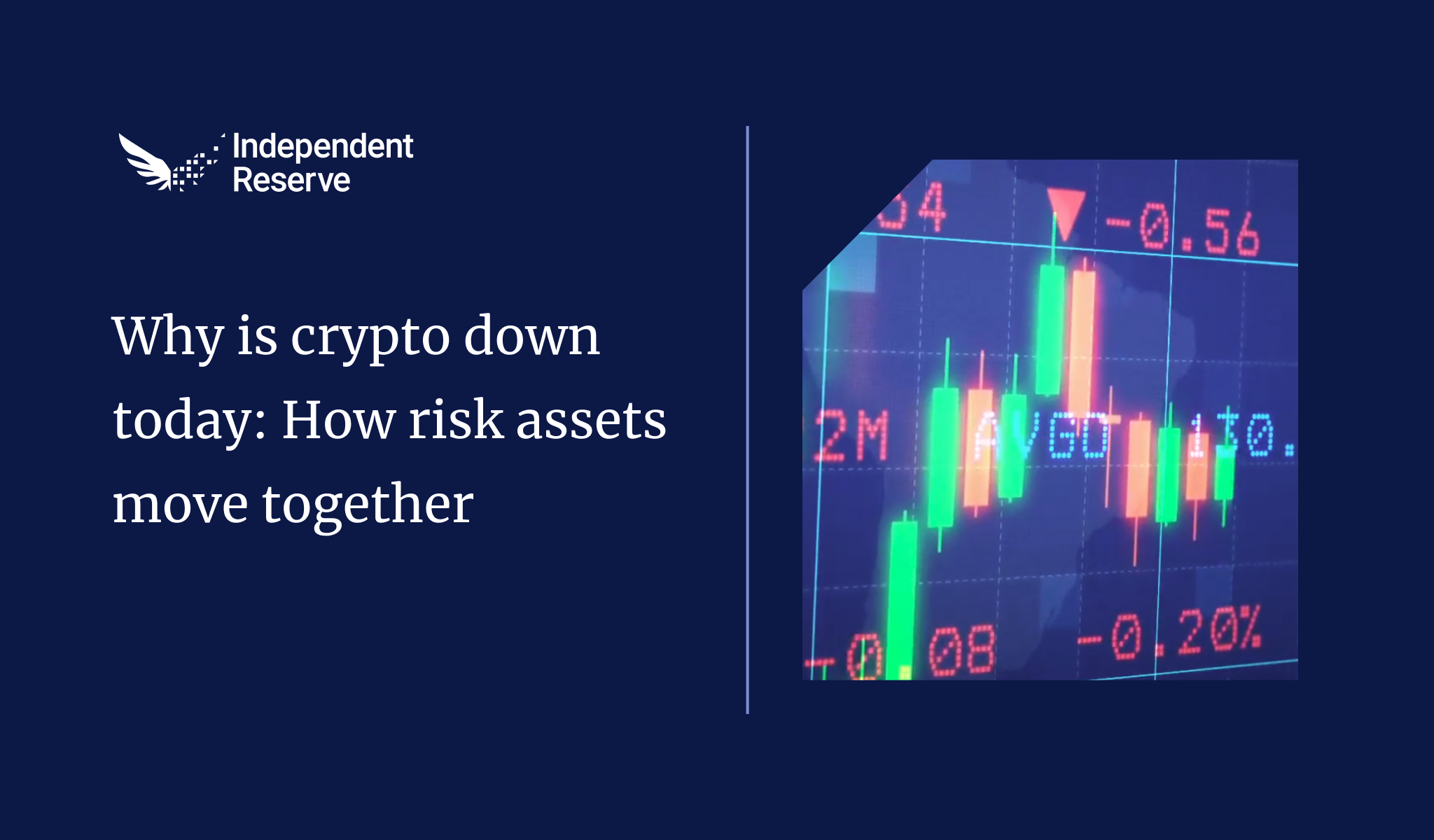In Markets
Things are starting to settle down, but with the effects of various collapses, bad loans and forced selling still working its way through the system, anything could happen. Bitcoin finished down 3% to AU$29,945 (US$20.7K) on a week ago, while Ethereum also managed to close the weekly in the green for the first time in 12 weeks, and is currently up 2% to AU$1,710 (US$1,180). XRP was up 6%, Solana (6%) and Polkadot (-5%). Documenting Bitcoin points out that in December 2020 when Bitcoin was at the same price it is now the Fear and Greed Index was at 92 or Extreme Greed. It’s currently at 12 or Extreme Fear.

From the OTC Desk
Without the direction of an imminent US Federal Open Market Committee (FOMC) meeting (the next scheduled for the 27th of July, 2022), macroeconomic markets have largely been driven by market positioning. In addition, both economic data and central bank rhetoric have been light this week, seeing bond yields drift lower and equity markets perform positively.
Chair Powell continues to begin each public address with:
I will begin with one overarching message. At the Fed, we understand the hardship high inflation is causing. We are strongly committed to bringing inflation back down, and we are moving expeditiously to do so. We have both the tools we need and the resolve it will take to restore price stability on behalf of American families and businesses. It is essential that we bring inflation down if we are to have a sustained period of strong labor market conditions that benefit all.
(This from the Semiannual Monetary Policy Report to Congress on the 23rd of June).
Markets now appear less tied to inflation forecasting and have now moved on to growth. This Wednesday we receive US GDP Growth Rate QoQ Final Q1 economic print which is forecast to be delivered at –1.5% versus +6.9% prior. Despite the sharp turn in growth, federal funds futures still expect the FOMC to increase the federal funds rate by 75bps in July.
In Australia, Reserve Bank of Australia Governor Philip Lowe spoke at the American Chamber of Commerce in Australia (Sydney). Of note, Governor Lowe expects the interest rate discussion for the 5th of July meeting to be centred around either a 25bp or 50bp increase; and without direct confirmation, appears to have taken a 75bp or 100bp increase off the table. Requesting that wage agreements in Australia begin with a 3% and not with a 5% increase, Governor Lowe challenged the futures markets’ near 4.25% expectation for the overnight cash rate for early next year as being too high. Time will tell who is right.
On the OTC desk – with cryptocurrency prices stabilising, flows have also become more balanced. There remains a great deal of caution around lending platforms having frozen withdrawals, and until this is resolved cryptocurrencies will trade with caution. In less liquid trading environments, positioning has an ability to push around market prices, and we continue to see this as a theme in the short term – something to be prepared for. As previously mentioned, the desk has always seen high volumes of stable coin flow, particularly USDC and USDT. While we continue to see good flow, volumes have been down over the most recent week, as the velocity of turnover in Defi remains reduced.
For any trading needs, please don’t hesitate to get in touch.
Worst bear market ever?
Glassnode’s latest report argues the duration and scale of capital destruction this year means “2022 is the most significant bear market in digital asset history.” It points out that Bitcoin and Ethereum both traded below previous cycle ATHs for the first time and the bear market has seen Bitcoin fall below half the 200-day moving average and half of the Mayer Multiple – something only seen before on 84 days out of 4160 trading days. The spot price has fallen below the realised price, something that’s only happened on 13.9% of all trading days. Glassnode concluded the market is in the midst of a capitulation event which often marks the bottom. ZYCrypto had a round-up of other metrics suggesting the bottom for Bitcoin is near. However, Glassnode says the outlook for Ethereum is still uncertain with the ‘Value Captured Per Byte’ metric showing a reading of 30c. Historically Ether has formed market bottoms around 15c.

Bitcoin price has fallen below 0.5 MM for the first time since 2015: Glassnode
FUD and the short seller
Celsius, Nexo and now Tether have all claimed to be the targets of coordinated FUD and shorting. Tether CTO Paolo Ardoino retweeted a story about hedge funds borrowing hundreds of millions to short USDT since Terra’s collapse. He thinks the funds believe the Tether truthers that USDT is unbacked. He argued that Tether processed US$7B (AU$10.1B) in redemptions in 48 hours “something almost impossible even for banking institutions” and US$16B (AU$23.1B) in a month, equating to 19% of its reserves. “Eventually these hedge funds that borrowed and shorted billions of USDT will need to buy them back. What will happen then?” he asked.
S2F is dead
Ethereum co-founder Vitalik Buterin has taken aim at the Stock To Flow Bitcoin price model, which did well during the bull run, but looks way off now with Bitcoin supposed to be at US$72K (AU$104K). “I know it’s impolite to gloat and all that, but I think financial models that give people a false sense of certainty and predestination that number-will-go-up are harmful and deserve all the mockery they get,” he said.

Contagion part 11-29
The WSJ has a list showing the contagion we know about so far. Voyager Digital has issued a notice of default to Three Arrows Capital for failing to make required payments on a loan of 14,250 BTC and 350M in USDC. This threatens Voyager’s viability even after it accessed a US$200M (AU$289M) line of credit from FTX. The FTX exchange also extended a US$250M (AU$361M) line of credit to BlockFi, but it came with conditions attached that could see all the current shareholders wiped out, so BlockFi is trying to stitch up a new deal with Morgan Creek Digital. Messari’s Ryan Selkis tweeted: “It does look like 3AC will wipe out BlockFi, Voyager, Celsius, and likely all of Genesis’ lifetime revenue… Every major crypto lender. Gone.” Rumours also started up this week that Nexo would be the next to fall, but it seems like FUD at this stage. Goldman Sachs has downgraded Coinbase to a Sell rating. Australian crypto payment firm Banxa has announced a reduction in staff numbers by 30%, mostly from its too-fast expansion to Europe and Indonesia. Meanwhile, Binance is looking to take advantage of the turmoil with 50 to 100 mergers and acquisitions.
Celsius to fight bankruptcy
Goldman Sachs is reportedly looking to raise US$2 billion (AU$2.89B) from investors to buy up distressed assets from CeFi platform Celsius, which is in the middle of a slow-motion collapse. Equity crowdfunding platform BnkToTheFuture boss Simon Dixon says the Goldman Sachs story isn’t true and he’s got his own rescue plan. Celsius is also fighting a recommendation from its own lawyers that it file for bankruptcy. It apparently believes users will get more back if it has time to unwind trades stuck in illiquid positions. Users can show support for the plan by engaging hodl mode on their accounts.

DeFi and DAOs
Harmony’s Horizon bridge between Ethereum and Binance Smart Chain lost US$100 million (AU$144M) in tokens this week. Users had earlier called attention to the fact that the bridge was secured by a multisig that only required two signatures to initiate transactions – a common security hole in DeFi. Meanwhile, a Chainalysis report into ten major DAOS, found less than 1% of governance token holders have 90% of the voting power. This was most recently seen in the Solend debacle where a vote to take over a whale’s account was carried by 1.1M yes votes — 1 million of which came from a single voter.
Bitcoin uses less power
Power consumption on the Bitcoin network has fallen from a peak of 16.09 gigawatts down to 10.65 gigawatts. Hash power hit an all-time high of 266 TH/s on June 13 but has fallen to around 202.8 TH/s today. Bloomberg reports that around US$4B (AU$5.8B) in loans to miners are under stress due to the price crash, with an increasing number underwater as the mining rigs they used for collateral have halved in value. Santiment reports some good news, however, with just 9.3% of the Bitcoin supply on exchanges, the lowest level since November 2018. By contrast, around 38.4% of the Tether supply is on exchanges. “The ratio of Bitcoin’s supply continues staying low at levels last seen in November 2018. This is a good signal of limited future sell-off risk. In the meantime, Tether supply continues skyrocketing on to exchanges, indicating greater buying power,” Santiment noted.
MAS cracking down on bad crypto behaviour
In a recent interview with the Financial Times, the chief fintech officer at the Monetary Authority of Singapore (MAS), Sopnendu Mohanty, said the central bank would be “brutal and unrelentingly hard” on bad behaviour in the crypto industry. Also mentioning, “we have been called out by many cryptocurrencies for not being friendly. My response has been: Friendly for what? Friendly for a real economy or friendly for some unreal economy?”.
Mohanty made mention of the “extremely draconian” and “painfully slow” due diligence process for licensing crypto businesses, alluding to the conservative stance the MAS has toward crypto. This further highlights Independent Reserve’s rigour around our policies, procedures, and ability to execute – we were the first retail exchange to be granted a licence by the MAS, and since the introduction of licensing for crypto firms in Singapore, over 100 licence approvals had been knocked back by the regulator.
Until next week, Happy Trading!


